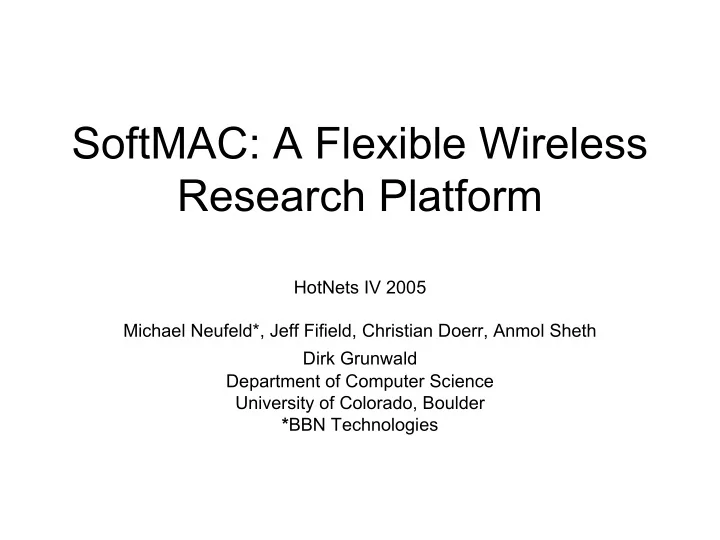

SoftMAC: A Flexible Wireless Research Platform HotNets IV 2005 Michael Neufeld*, Jeff Fifield, Christian Doerr, Anmol Sheth Dirk Grunwald Department of Computer Science University of Colorado, Boulder * BBN Technologies
Outline • Motivation and goals • System design • Application examples • Conclusion
Software Defined Radios • Enables construction of adaptive, resilient and multipurpose networks • Building block for “cognitive radio” and “spectrum agile radios” – Temporal and spatial reuse of the spectrum • Dynamic tuning of PHY layer “knobs and dials” like – Transmission rate / modulation – FEC / ARQ policies & adaptation – Channel adaptation – Frequency bandwidth Pic. Source – DARPA XG Vision RFC
Adaptive MAC – Building resilient multipurpose networks • Require similar set of “knobs and dials” at the MAC layer • Adaptive/Heterogeneous MAC’s can lead to significant performance improvements • Example: Media reservation – CSMA/CA for low contention periods – TDMA mechanism under high contention
Adaptive MAC - 802.11 “One size does not fit all” 802.16 based wireless backbone FEC+TDMA Security Outdoor long enhancements distance links to WEP 802.11 MAC Synch. TDMA 802.11i Protocol VoIP, video Smart antennas and other QoS (directional, Mesh apps MIMO, etc) Networks 802.11e, fast D-MAC handoff, etc Multi-radio MAC
Limitations of simulation + Assists rapid prototyping + Flexible and repeatable experimentation + Allows easy scalability testing - Abstracts away a large number of real world problems - Unrealistic assumptions of the real world
SoftMAC - Goal Build a platform that allows flexible and repeatable MAC layer experimentation • What properties should such a platform have? • Once such a platform exists, what should the software interface be?
Existing platforms Regular 802.11 Sensor Networks 10 10 8 8 6 6 4 4 2 2 0 0 Cost PHY MAC Portability Cost PHY MAC Portability Ubiquitous and low cost. Almost all Low cost, low power and highly functionality hidden in firmware portable. Very low data rates. Std. Inexpensive SDR Expensive SDR 10 10 8 8 6 6 4 4 2 2 0 0 Cost PHY MAC Portability Cost PHY MAC Portability Reasonably low cost. Limited Very expensive and not portable. integration with MAC. Overkill for MAC layer experiments.
SDR platform examples Std Inexpensive SDR platform - $700-$800 Expensive SDR platform - $9000- $10,000
SoftMAC • COTS 802.11 SoftMAC 10 hardware and mostly 8 open-source software, 6 4 i.e. cheap and 2 ubiquitous 0 Cost PHY MAC Portability • Based on Atheros/MADWIFI drivers • Surprising flexibility at MAC layer in monitor mode Price ≈ $60
Wish list for a MAC layer experimentation platform Desirable features “Undesirable” 802.11 features Support transmission of custom Fixed 802.11 preamble and header headers formats formats Fine control over timing of frame PHY CCA, Random backoff, virtual transmission (TDMA like protocols) carrier sensing, etc Provide visibility into PHY layer Supports no mechanism to read/write PHY parameters Support reception of arbitrary 802.11 state machine filters frames, including error frames malformed and error frames Compatible with existing 802.11 devices Low cost and portable
Controlling MAC frame format Switch between long/short preamble
Controlling transmission timing Cannot eliminate DIFS interval. However, can control PHY CCA. Allows transmission in presence of noise in environment Control “random” backoff NAV updates are suppressed in by setting the CW interval monitor mode to 1
Timing micro benchmarks • Frame transmission rate – SoftMAC can send MAC frames every 91µ sec ±1µ sec A → B A → C A → D • Turn-around time t duration t 1 t 2 B → A A → B A → B Time t turnaround = t 2 - t 1 – t duration = 166 u sec ± 1 u sec
Visibility into PHY • Measure noise floor • Receive CRC and PHY corrupted frames • Diagnose the type of PHY error that corrupted the frame (CCK/OFDM timing errors, illegal rates, illegal parity etc.) • Set 802.11 specific parameters (CTS/ACK timeout, force PHY CCA calibration, etc.)
Applications of SoftMAC • TDMA based MAC • Adaptive Reed Solomon MAC • MultiMAC [DySpan ’05] – Dynamically switch between different MAC protocols
Adaptive Reed Solomon MAC Click s = sample period e = error threshold Modular RS(255,223) c = No error threshold Router - Measure error frames for sample period SoftMAC - if error frames > error thresh then signal “start RS” - if error frames < No error thresh then signal “stop AR5212 RS” Reed Solomon MAC for s=10, e=2, c=10 • On average 75% of packets were RS encoded Recv Valid RS Recv Recv • Packets dropped due to errors reduced from 50% to less than 10% RS 3859 3660 2971 802.11 3845 1850 0
Limitations of SoftMAC • Very limited compared to a “real” SDR – Little flexibility at the PHY layer – Experimentation restricted to the MAC layer • True innovation for (multihop) wireless is going to rely on new PHY’s – “Relay architectures” – radio repeaters • Network community needs platforms to foster systems research rather than paper designs
Conclusions • Flexible, low-cost MAC layer experimentation platform • Significantly more flexible than stock 802.11 • Prove / disprove a significant body of work in “cross-layer” wireless research • Download from - http://systems.cs.colorado.edu/projects/softmac “[SoftMAC] is a hack, but a very clever and useful hack” - External reviewer (Jay Lepreau)
Recommend
More recommend